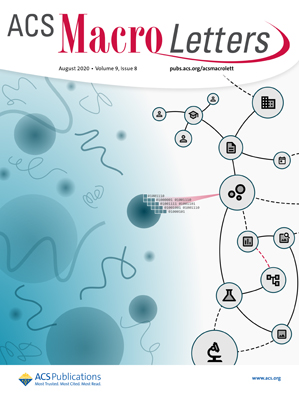具有可控凹痕的可生物降解纳米碗
IF 5.1
Q1 POLYMER SCIENCE
引用次数: 0
摘要
纳米碗由于其独特的凹形结构和内部腔体,在生物成像、货物运输和疾病治疗等生物医学应用中显示出巨大的潜力。然而,缺乏可操纵尺寸(特别是凹痕尺寸)的可生物降解纳米碗仍然是其在生物医学领域深入探索和应用的障碍。本文通过溶剂开关方法,成功地通过接枝多肽[命名为TPE-P(GAAzo21-stat-GA29)]的自组装获得了基于多肽的纳米碗。通过氢键和π -π堆积相互作用的协同作用,可以通过改变初始多肽浓度或自组装时的助溶剂来控制纳米碗的大小和相应的凹痕。此外,这种多肽基纳米碗在体外具有生物相容性和可生物降解性,这可能促进未来生物医学纳米碗的发展。本文章由计算机程序翻译,如有差异,请以英文原文为准。

Biodegradable Nanobowls with Controlled Dents
Nanobowls show promising potential in biomedical applications, such as bioimaging, cargo delivery, and disease theranostics, due to their unique concave structure and interior cavities. However, the lack of biodegradable nanobowls with manipulable size (especially the dent size) still exists as an obstacle for their in-depth exploration and application in biomedical fields. Herein, polypeptide-based nanobowls are successfully obtained by the self-assembly of a graft polypeptide [named TPE-P(GAAzo21-stat-GA29)] via a solvent-switch method. Through the synergistic effect between the hydrogen bonding and π–π stacking interactions, the size of nanobowls and the corresponding dents can be facilely controlled by altering either the initial polypeptide concentration or the cosolvents in self-assembly. Furthermore, such polypeptide-based nanobowls are demonstrated to be biocompatible and biodegradable in vitro, which may promote the development of biomedical nanobowls in the future.
求助全文
通过发布文献求助,成功后即可免费获取论文全文。
去求助
来源期刊
CiteScore
10.40
自引率
3.40%
发文量
209
审稿时长
1 months
期刊介绍:
ACS Macro Letters publishes research in all areas of contemporary soft matter science in which macromolecules play a key role, including nanotechnology, self-assembly, supramolecular chemistry, biomaterials, energy generation and storage, and renewable/sustainable materials. Submissions to ACS Macro Letters should justify clearly the rapid disclosure of the key elements of the study. The scope of the journal includes high-impact research of broad interest in all areas of polymer science and engineering, including cross-disciplinary research that interfaces with polymer science.
With the launch of ACS Macro Letters, all Communications that were formerly published in Macromolecules and Biomacromolecules will be published as Letters in ACS Macro Letters.

 求助内容:
求助内容: 应助结果提醒方式:
应助结果提醒方式:


